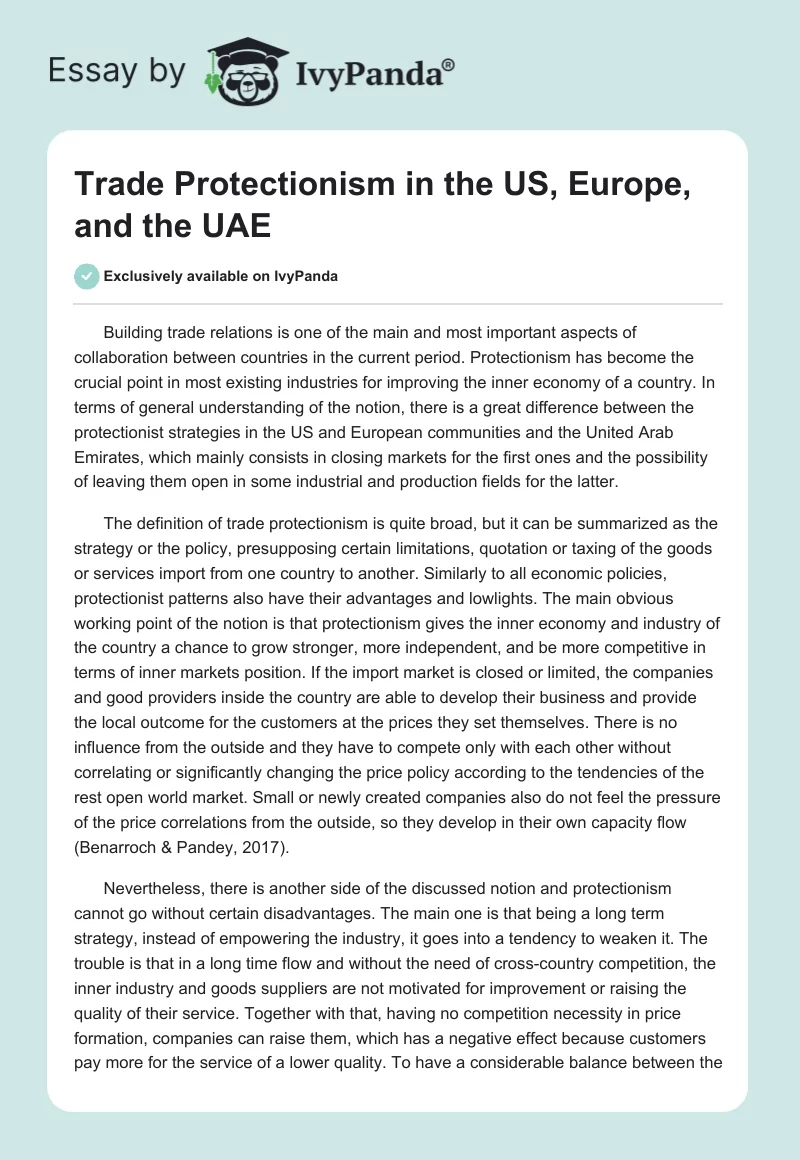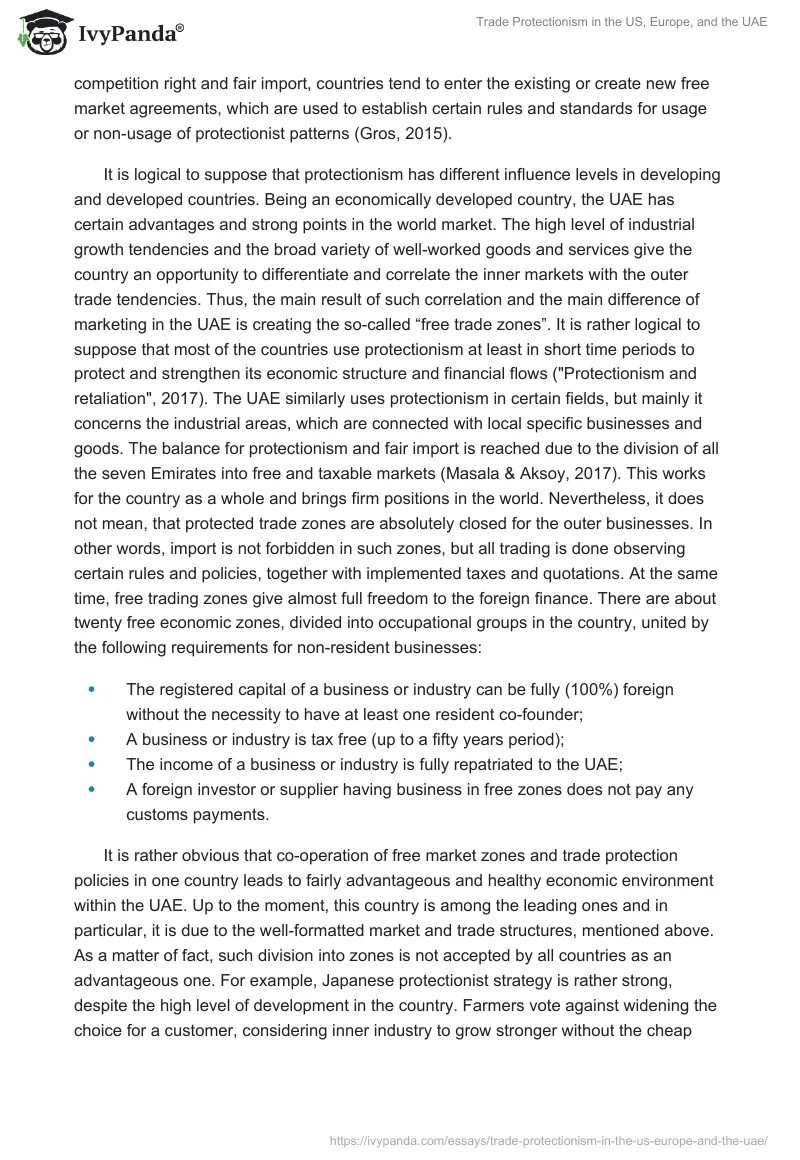Building trade relations is one of the main and most important aspects of collaboration between countries in the current period. Protectionism has become the crucial point in most existing industries for improving the inner economy of a country. In terms of general understanding of the notion, there is a great difference between the protectionist strategies in the US and European communities and the United Arab Emirates, which mainly consists in closing markets for the first ones and the possibility of leaving them open in some industrial and production fields for the latter.
The definition of trade protectionism is quite broad, but it can be summarized as the strategy or the policy, presupposing certain limitations, quotation or taxing of the goods or services import from one country to another. Similarly to all economic policies, protectionist patterns also have their advantages and lowlights. The main obvious working point of the notion is that protectionism gives the inner economy and industry of the country a chance to grow stronger, more independent, and be more competitive in terms of inner markets position. If the import market is closed or limited, the companies and good providers inside the country are able to develop their business and provide the local outcome for the customers at the prices they set themselves. There is no influence from the outside and they have to compete only with each other without correlating or significantly changing the price policy according to the tendencies of the rest open world market. Small or newly created companies also do not feel the pressure of the price correlations from the outside, so they develop in their own capacity flow (Benarroch & Pandey, 2017).
Nevertheless, there is another side of the discussed notion and protectionism cannot go without certain disadvantages. The main one is that being a long term strategy, instead of empowering the industry, it goes into a tendency to weaken it. The trouble is that in a long time flow and without the need of cross-country competition, the inner industry and goods suppliers are not motivated for improvement or raising the quality of their service. Together with that, having no competition necessity in price formation, companies can raise them, which has a negative effect because customers pay more for the service of a lower quality. To have a considerable balance between the competition right and fair import, countries tend to enter the existing or create new free market agreements, which are used to establish certain rules and standards for usage or non-usage of protectionist patterns (Gros, 2015).
It is logical to suppose that protectionism has different influence levels in developing and developed countries. Being an economically developed country, the UAE has certain advantages and strong points in the world market. The high level of industrial growth tendencies and the broad variety of well-worked goods and services give the country an opportunity to differentiate and correlate the inner markets with the outer trade tendencies. Thus, the main result of such correlation and the main difference of marketing in the UAE is creating the so-called “free trade zones”. It is rather logical to suppose that most of the countries use protectionism at least in short time periods to protect and strengthen its economic structure and financial flows (“Protectionism and retaliation”, 2017). The UAE similarly uses protectionism in certain fields, but mainly it concerns the industrial areas, which are connected with local specific businesses and goods. The balance for protectionism and fair import is reached due to the division of all the seven Emirates into free and taxable markets (Masala & Aksoy, 2017). This works for the country as a whole and brings firm positions in the world. Nevertheless, it does not mean, that protected trade zones are absolutely closed for the outer businesses. In other words, import is not forbidden in such zones, but all trading is done observing certain rules and policies, together with implemented taxes and quotations. At the same time, free trading zones give almost full freedom to the foreign finance. There are about twenty free economic zones, divided into occupational groups in the country, united by the following requirements for non-resident businesses:
- The registered capital of a business or industry can be fully (100%) foreign without the necessity to have at least one resident co-founder;
- A business or industry is tax free (up to a fifty years period);
- The income of a business or industry is fully repatriated to the UAE;
- A foreign investor or supplier having business in free zones does not pay any customs payments.
It is rather obvious that co-operation of free market zones and trade protection policies in one country leads to fairly advantageous and healthy economic environment within the UAE. Up to the moment, this country is among the leading ones and in particular, it is due to the well-formatted market and trade structures, mentioned above. As a matter of fact, such division into zones is not accepted by all countries as an advantageous one. For example, Japanese protectionist strategy is rather strong, despite the high level of development in the country. Farmers vote against widening the choice for a customer, considering inner industry to grow stronger without the cheap import. It can also be explained by the lack of competitiveness and deep traditionalism of farming and its industry in Japan (“Japanese farmers reject free trade group”, 2013).
Overall, despite the fact that protectionism has its own peculiarities and differences for various economic flows, the UAE manages to combine both freedom and closed features of trade markets, which seems to be a developed decision for stability of the country’s economy. Protected zones do not let foreign investors fully interfere with specific local industries, while free trading areas give a constant financial flow from the outside in repatriated capitals, which leads to a certain kind of balance in the economic system of the United Arab Emirates.
References
Al Jazeera English. (2015). Japanese farmers reject free trade group. Web.
Benarroch, M. & Pandey, M. (2017). The impact of imports and exports on the size and composition of government expenditures. International Journal Of Economics And Finance, 9(3).
Gros, D. (2015). Protectionism in a framework with intra-industry trade. Tariffs, quotas, retaliation, and welfare losses. New York, NY: Harper Collins Publishing.
Masala, Ö. & Aksoy, T. (2017). Why Do Labor Standards Differ Across Muslim Countries? Handbook Of Research On Unemployment And Labor Market Sustainability In The Era Of Globalization. Web.
Protectionism and retaliation. (2017). Web.


